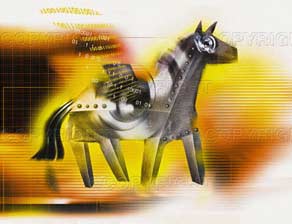Virus is out of date, rebel Trojan
 It seems that the end of the mass e-mail worms has come close as spy programs account for 86% of all infections reported by Sophos (UK) in April. .
It seems that the end of the mass e-mail worms has come close as spy programs account for 86% of all infections reported by Sophos (UK) in April. .
Statistics of Sophos' recent malicious attacks show that NetSky.P - the virus that has been spreading over the past two years - continues to be a digital computer threat once it comes back to the top, taking the place. of Zafi.B. However, the number of e-mail viruses in general continues to decline, and instead the spread of the types of Trojans that hackers use to download malicious code, track user activity or take control computer.
" The e-mail virus is at the top of the list of dangerous software in April but the new Trojan is really the biggest threat to network security ," said technology consultant Carole Theriault of Sophos. ' These spyware are being developed by hackers and become more sophisticated to target specific targets. They are programs that are harder to detect than viruses and are therefore more accessible to victims . '
The 10 most dangerous software rankings in April saw the return of two Mytob.C and Mytob.AS variants, next to a name that first appeared as Dolebot.A e-mail worm.
According to Sophos, on average, every 141 e-mails circulating in the past month has 1 virus. The number of attacks via e-mail appeared in January was 1,054, bringing the total number of e-mail viruses identified by Sophos to 121,096.
The 10 most dangerous viruses in April 2006 (in brackets are the rate of notifications received by Sophos):
1. Netsky.P (18.5%)
2. Zafi.B (16.9%)
3. Nyxem.D (8.5%)
4. MyDoom.AJ (3.9%)
5. NetSky.D (3.9%)
6. Mytob.FO (3.6%)
7. Mytob.C (2.8%)
8. Mytob.Z (2.6%)
9. Dolebot.A. (2.2%)
10. Mytob.AS (1.3%)
Other types: 35.8%.
PK
You should read it
- The virus grew the most in October
- Zotob worm failed to make a big impact
- August virus ranking
- September security: Users 'oily' every warning
- Top 10 most dangerous malicious codes in April
- Nyxem.D ranked fourth out of 10 dangerous viruses at the beginning of the year
- Virus attacks via e-mail are decreasing
- Top 10 most dangerous viruses in November
- Microsoft is about to have updates for Mail, Calendar and People on April 2
- April Fools - Interesting origins and meanings you should know
- Top 10 most dangerous viruses in March
- Lie, joke April Fool's Day for April 1 adds fun (Part 2)






 Download Rebel Galaxy, the space combat game that is being free on Epic Store
Download Rebel Galaxy, the space combat game that is being free on Epic Store What is a Trojan? How to avoid trojan attack?
What is a Trojan? How to avoid trojan attack? Smartphone was attacked by ZeuS Trojan virus
Smartphone was attacked by ZeuS Trojan virus What is Trojan? How to avoid Trojan horse virus
What is Trojan? How to avoid Trojan horse virus Appeared Trojan Horse virus attacks Mac computers
Appeared Trojan Horse virus attacks Mac computers Appeared Trojans spy on businesses
Appeared Trojans spy on businesses